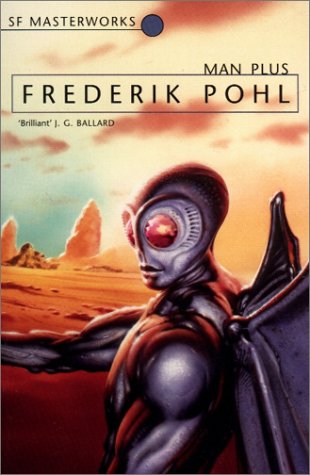|
 Although
Frederick Pohl is not as well known as Asimov or Heinlein, his roots in science
fiction go back just as far. Like Asimov he was involved in the Futurians,
an early group of science fiction fans in the 1930s. From the early 1940s to the
late 1960s he worked primarily as an editor and agent, while publishing a number
of stories and (usually in collaboration) novels. He edited Galaxy
magazine through the 1960s. Only in the 1970s did he devote his main energies to
novel writing, becoming one of the decadesí most important SF writers. Pohl is
still alive and has continued to publish books into his 80s. Although
Frederick Pohl is not as well known as Asimov or Heinlein, his roots in science
fiction go back just as far. Like Asimov he was involved in the Futurians,
an early group of science fiction fans in the 1930s. From the early 1940s to the
late 1960s he worked primarily as an editor and agent, while publishing a number
of stories and (usually in collaboration) novels. He edited Galaxy
magazine through the 1960s. Only in the 1970s did he devote his main energies to
novel writing, becoming one of the decadesí most important SF writers. Pohl is
still alive and has continued to publish books into his 80s.
Man Plus is one of his finest novels. By the late 1960s, many science
fiction writers had lost interest in realistic depictions of near-future space
flight, as the Apollo program appeared to move it out of the realm of
imaginative speculation. Pohl mixes the reality of an Apollo-style program with
a hearty dose of late-1970s disillusionment, while retain something on the old
thrill of space colonization. It also stands as something of a turning point in
the history of the future. On one hand, it deals with space travel and
colonization of alien planets -- a concern of science fiction since its earliest
days. On the other hand, its powerful use of the idea of the cyborg, its
cynical tone and the importance of computer technology to its plot prefigure the
cyberpunk literature of the 1980s. (It can also be seen as a parallel to
then-popular TV shows such as the Six Million Dollar Man and the Bionic
Woman -- "We can rebuild him. We have the technology. We can make him better
than he was. Better . . . stronger . . . faster.").
Discussion Questions
- What echoes of the mid-1970s do you see in the future as presented in this
book? How is its tone different from those of the earlier novels.
- How does Pohl treat science and technology?
- What attitudes does the story reflect toward the US space program? How
accurate do you find its depiction of the astronaut experience?
- How is America faring in this particular cold war future? Look
particularly at the treatment of the President and the military.
- How are computers treated in this book, and how does this compare to the
other stories (particularly the Asimov ones).
- Unlike any of the other authors we read, Pohl attempts a realistic
depiction of a marriage. How are Torraway's wife and the other female
characters treated? What does this tell us about shifting attitudes during the
era?
Resources
 | Pohl writes elegantly and insightfully about the early days of science
fiction, and its connection to a childhood in the Depression and a youth of
communist politics, in his memoir The Way the Future Was, a copy of
which is in the Colby library. |
 | Pohl's early novel, The Space Merchants (1953) was an effective
satire of a future dominated by corporate advertising. Many of Pohl's
novels of the 1970s and 80s explore the cold war, often in the context of
space travel. The best of these is Jem: The Making of a Utopia (1979)
-- a still more cynical account of interstellar colonization. His most popular
novel was the 1977 Gateway (winner of both Hugo and Nebula awards), set
in a more distant future in which people explore the universe in spaceships
left behind by a mysterious alien race. |
 | Plans to film the book appear to have foundered.
On-line gossip
suggests that film studio politics edged out plans for a faithful adaptation
in favor of scenarios in with either (a) a good cyborg battles a bad cyborg or
(b) everybody battles a race of intelligent Martians. This may be why most
futuristic films are so bad. |
|